#its good for gimmick continuity and character but not for punchline
Text
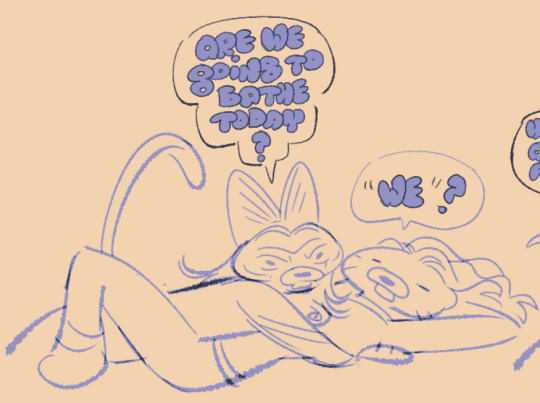

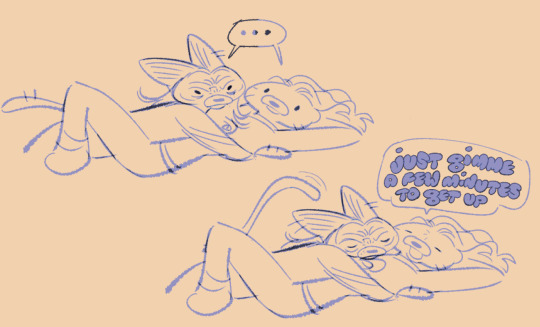
#a doodley#the funny thing being real human cheye uses the shower daydream to get his own ass in there#had to scribble this out before i (we?) showered bc i knew the feeling wldnt be there after...#i have a cow al smunker scribble i wanna get out afterwards#i was gonna make a version where talon also has some Option Text but#i dont think its the same. like he'd struggle to say thank you but its a fleeting accepted thing#unlike smunker who has to quickly analyze and toil between all options to stay true to himself while not making talon upset#or making a joke that would cause talon to shy away again#talon doesnt need option text you can see it all in what he doesnt say; which he relies on because he wont say it.#hmmmm i may remove the final smunker option text#its good for gimmick continuity and character but not for punchline#ok edited it out ^_^
255 notes
·
View notes
Text
I Liked Fates Before It Was Cool!: Conquest Part 1
Prologue
Opening Chapters
Chapters 6-14, in which if you squint really hard there might be a plot in there somewhere.
Chapter 6
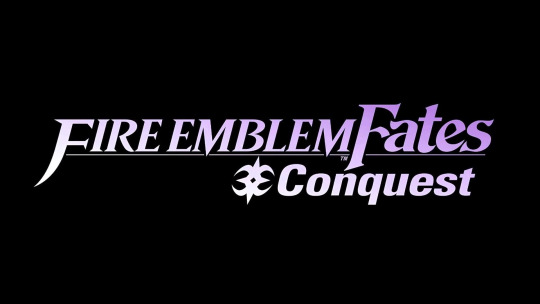
But let’s not be unfair right from the start. Conquest offers what I consider the best version of Chapter 6, both as a narrative introduction to the route and as a gameplay challenge fitting the difficulty of what’s to come. Birthright is basically just Ryoma soloing Xander and Revelation throws you against generics, but here you have to make use of all the Nohr royals to defeat all but one unit on the Hoshidan side - and being able to take care of Ryoma quickly enough nets you a prize of sorts in that you don’t have to beat up an unarmed Sakura. The chapter also sets up the tense undercurrent of Conquest that Corrin chose wrong, that the Hoshidans (except Takumi) think they’ve been brainwashed and that their love for their adopted siblings is meaningless. On the one hand it feels rather spineless that what is supposedly a villain campaign is hesitant to allow Corrin to own their choice and makes it sound like blatant railroading by the player, but on the other there’s something to be said for the contrast between how Xander and Ryoma deal with Corrin’s decision. After two refusals in Birthright Xander is happy to label Corrin a traitor and becomes determined to kill them for their choice, whereas Ryoma persists in his brainwashing theory and in so doing denies Corrin’s agency completely. That actually works fairly well as setup for an antagonist - if we allow that Ryoma is one, of course, and the game itself seems uncomfortable with the concept.
Chapter 7
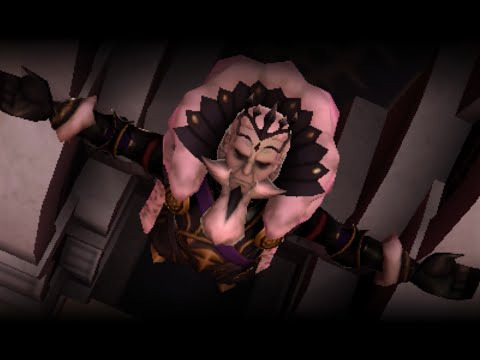
...And all my goodwill toward this story dries up almost immediately. There’s flat villainy, there’s a bunch of self-doubt from Corrin over their choice, and there’s foreshadowing that only adds to the confusion if you already know what’s going on. It’s kind of a mess, and it’s pretty much all downhill from here.
I have little to say about this chapter as it stands, except that it’s appropriately difficult and that the conflict feels fitting in terms of tone and atmosphere...even though it only exists because of the aforementioned flat villainy. I instead want to zero in on the moment pictured above, in which Garon “prays” to Anankos to deliver unto him the plot of the next few chapters in front of Corrin and Iago and the Nohr royals. Bizarrely, it’s Iago who goes furthest in calling Garon out on how absurd this is, though not even he bothers to ask who or what Anankos is or if he’s the same entity as Nohr’s Dusk Dragon.
Ok, I know I might be the only person in the fandom who regularly complains about the absence of pseudo-Catholic elements in Fates when they’re present in every other game in the series, but on a fundamental level I do get it. The priest -> sage/war monk class line from Awakening was given to Hoshido, so it makes perfect sense that those classes would be shifted over to the blend of Shintoism and Buddhism that comprises Japanese spirituality. It’s also not unheard of for a nation or group of people in FE to worship a dark dragon/god in lieu of the main organized faith, ex. the Lopytrians from Jugdral, Rigel’s Duma Faithful, and Plegia’s Grimleal. As seen with Salem from FE5 and Tharja and Henry from 13 it’s even fairly common for playable dark magic users in the games to come from the ranks of those faiths. I therefore don’t have a problem with the theory that there’s a theological element to Nohr’s dark mages and that it ties into the Dusk Dragon - who may or may not also be Anankos - in some way. The problem is that we never see any definitive evidence that this is the case, not even enough to understand how unusual it is in this scene to see Garon praying to Anankos. When Iago sounds like the closest thing to a voice of a reason you know the plot’s got some problems. For all we’re told Nohr’s clergy are just bookworms moonlighting as strippers with a crow feather fetish.
Chapter 8
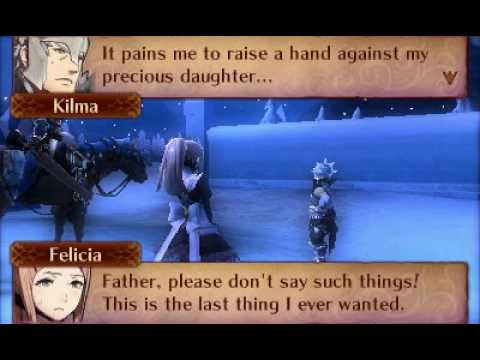
It’s strange how easy it is to forget this guy exists since he only appears in Conquest in this one chapter, but the Ice Tribe maids do indeed have a father. Where was he during Chapter 17 of Birthright?
This brings up an interesting - or as some would probably call it, lazy - quirk of Fates’s map design. The early and midgame sections of all three routes are full of maps that get reused across routes, or different maps of the same location like the previous one and Birthright Chapter 18. I’m feeling rather charitable about this decision personally, for two reasons:
1) In most cases the reused maps are approached from different angles and feature different, sometimes opposing gimmicks. The Ice Tribe village map, for example, sees you racing to visit as many villages as possible in Conquest but encourages you to avoid them in Birthright, and the function of the Dragon Veins in the middle of the route differs depending on the route.
2) Fates’s worldbuilding needs all the help it can get, and visiting the same locations in multiple routes adds a degree of continuity that the story on its own often struggles to display.
See, cost-cutting measures don’t have to be a bad thing if you use them creatively!
This chapter also deserves some praise for having a more plausible point of conflict than its Wind Tribe counterpart in Birthright. Instead of Iago’s shenanigans Elise grabs the conflict ball because no one taught her basic diplomacy, and Corrin saves the day through their first of many acts of pacifism on this route. It is a bit strange to have the characters talking about how Corrin’s army spared everyone just after you’ve finished mowing down a bunch of generics, but not unlike Niles I can use my imagination.
Chapter 9

A wild loli appears! Ugh...Nyx is one of several characters in Fates who could have been interesting with better execution. As it is, her best use is as a punchline or somebody’s fap material of course.
This chapter has nothing to do with her though really. Instead it’s just a set of contrivances - how did a Hoshidan force make it so deeply into Nohr so quickly (for comparison, Corrin’s army reaches the same location in Birthright by Chapter 20), and why did they bring Azura all this way with them if their only plan was to kill her? I do appreciate the reminder that Nohr and Hoshido are actually at war now as the rest of the Conquest’s early plot is more concerned with putting down rebellions, but some kind of logical reason for Azura’s reappearance would have been nice.
Still, this chapter goes further than most at showing an explicit example of Hoshidan racism, even if Azura is quick to absolve the royals (except Takumi, I assume) of any wrongdoing. I genuinely have no idea if we’re meant to interpret this as Stockholm Syndrome, or if the writers couldn’t bear to vilify all of Hoshido even for one chapter.
Chapter 10

Like a number of other defense maps in the series, this is the most infamous chapter of its game, and depending on who you’re using and how it can indeed live up to its reputation. I don’t care for how this makes for an uneven bump in Conquest’s difficulty curve, but with such varied chapter goals and mechanics on this route that was likely inevitable at some point.
For all that it’s a memorable piece of gameplay though there’s not too much to talk about in terms of story. Takumi is established as a strong and motivated antagonist right from his first reappearance after the route split, and as I said back in Birthright it’s a good look for him. He and Oboro are among the few Hoshidans who really make more sense as antagonists than as allies, and even though it devolves into yet another round of possession in the end there’s something very real to Takumi’s feelings of betrayal and inadequacy, to say nothing of his grief over his mother which unlike in Birthright barely comes up otherwise.
Also, Camilla is here, but with only a bit of retainer banter to flesh her out she’s more or less the same as FE10 Haar in Chapter 2-E of that game: overleveled flying death, with only a few stray bits of effective damage to worry about.
Chapter 11

The Sevenfold Sanctuary appears again, this time with tricky skill combos to contend with like archers with Counter and ninjas with Lunge as well as more of the by now common enemy pair-ups and a boss with an unfair enemy-only weapon. Does anyone else find it strange just how many such weapons exist in Fates?
In this route it’s the Hoshidans who get to troll Corrin, dragging the Rainbow Sage up Mount Sagesse for no real reason and doing their best to not sound like they’re invading a sovereign territory and kidnapping its most venerable inhabitant who also happens to be an ancient dragon. Granted the Nohrians’ mission feels a bit confused as well, as dialogue vacillates between Garon wanting to conquer Notre Sagesse and everyone else wanting the Rainbow Sage’s power. The two sort of come together in the end with Iago ordering the Sage’s death, though if there’s a logical explanation for Garon/Anankos’s continued desire to see Corrin suffer but not die it’s beyond me. That Corrin gets an eventual sword power-up out of the deal feels almost accidental on this route.
Incidentally, while he doesn’t get the gravity of a potential death scene in this version I do like how Kaze joins up with the Nohrians. It conveys the subtext of his connection to Corrin while not coming across as a weird obsession like his approximate counterpart Silas does in Birthright. Speaking of which, I’ve noticed that Silas gets a decent amount of the protagonist chorus roles in Conquest even when some of the royals are available. Eh...they are supposed to be BFFs.
Chapter 12
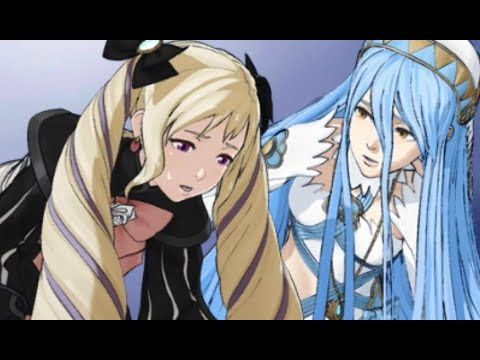
Now that’s just not as funny as the version of this picture with Takumi.
Elise comes down with a case of the plot, and as a consequence we bear witness to Ryoma’s most infamous act of dickishly non-heroic behavior. I’ve seen it argued back and forth that Ryoma withholding medicine from Elise in an attempt to coerce Corrin into returning to Hoshido constitutes a war crime, but regardless of semantics it is a surprisingly underhanded tactic for someone like him. Now that I think about it Birthright shows off this side of him as well, when he disguises himself as a Nohrian soldier at Cheve to ambush Leo. Not exactly becoming a shining exemplar of heroism here awkwardly forced into the antagonist role...but then he goes off about how his retainers have a more righteous cause than Xander’s and suddenly I lose what little sympathy I had for him. Sure, one of the retainers he’s insulted is Peri, but on the whole that’s an eminently hateable level of self-righteous posturing.
This chapter is quite fun, if a bit chaotic with all the random effects from the pots. For some reason I always forget about the turn limit, which can become an unexpected source of stress when there are shrine maidens spamming status staves to slow you down and such. Fates (and Conquest specifically) is the one game other than Thracia that frequently turns enemy staff wielders into serious threats, and this chapter combined with Azama’s Hexing Rod in the previous one show that off thoroughly.
Chapter 13
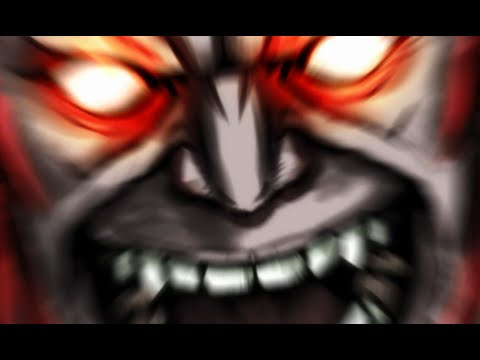
Pictured: a subtle and nuanced depiction of villainy.
Aside from his sudden reappearance and this one still, Hans is actually...not that bad here though? Corrin points out how weird it is that they (and the player) are expected to forgive him after he attempted to kill Corrin at the Bottomless Canyon, and the worst atrocities of Hans’s army - particularly Scarlet’s death - are effectively gruesome because they’re left for the player to imagine. It’s comparable to how FE8 handles the ghastly presence of Orson’s wife. It is pretty silly how much is made over Hans clearly enjoying his work when Peri was recruited in the last chapter and Reina is also in this game (in this chapter, even), or that explicit bloodlust among the playable cast has shown up before in past FEs in characters like FE7 Karel. Player-centered morality, yay!
In any case, there’s also a good deal of genuine character complexity on display in this chapter too. Takumi is still consumed by grief and rage and lashes out specifically at the bond Corrin shares with the Nohrian sisters, calling attention to his increasing isolation from even his own siblings. Between taking an arrow in a cutscene and last chapter’s illness Elise just can’t catch a break, can she? Camilla too gets to show a rare bit of character for this route, encouraging Corrin to keep their head down and go along with Garon’s orders because self-centered pragmatism is how she’s learned to survive in situations where she can’t solve problems with violence and/or sex.
Chapter 14
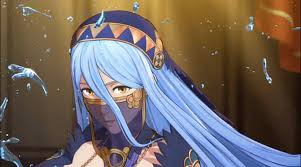
What an incredibly effective disguise. No one would ever recognize her.
Ok, ok, the audience at the opera is seeing her from a distance and obscured by all the water effects, but it’s still pretty dumb that Corrin of all people can’t put two and two together here.
Honestly, as much as I enjoy the opera house setting and praised its appearance in Birthright this chapter all falls into that same generally silly vein. There’s again no logical explanation provided for Garon’s trip to Nestra, the enemy combatants on this map are a random squad of Hoshidans unrelated to the unfolding story, Keaton’s recruitment has even less buildup than Kaden’s did, and everything culminates in Leo teaching Corrin the obscure and arcane art of lying and in so doing bequeathing him with a sword upgrade because that’s what passes for (anti)heroism on this route. There’s not even much in the way of gameplay to discuss, which is disappointing when contrasted against the Birthright version.
I would however like to close this post by reiterating the point I made at the start: so far, this route is severely lacking in an actual plot. All of Corrin’s movements since returning to Nohr have been directed by Garon (and Anankos by extension, though his motives remain vague even if you know the full story). In a way this helps to reinforce the feeling that the Nohrian royals are trapped in abusive situation, though that would be an unusually deep psychological reading of what is in reality an unfocused plot. The following chapter and what comes of it ought to be proof enough that any similarities between Conquest’s narrative structure and the familial issues of its main cast are purely coincidental.
Next time: Conquest Chapter 15 - 20
6 notes
·
View notes
Photo
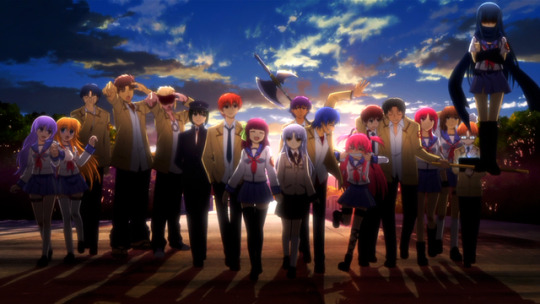
Angel Beats! Review: (LOL this is a long ass review. Please enjoy as i felt like it was appropriate for this one to be more from-the-heart like the anime itself :o and Yes, I highly recommend it as you can see. Happy watching)
How to begin... It was a Saturday night when my coworker suggested we watch this anime that he held in high regard. The three of us had just finished work and planned to relax with food, burritos from La Vics. After deciding that we would enjoy our late night meal with a show, my coworker logged into his Crunchyroll account and then... we all fell asleep. The End
Jokes aside, I didn’t expect to binge watch an entire 12 episode series in a night. Especially when I had work the next morning. But like the unreal, exhausting next day where I struggled to stay awake for the next 7 hours of work, there is probably no other that comes to mind in terms anime when it comes to Angel Beats!. Animation, Soundtrack, Emotion, Angel Beats practically topped every expectation that I had whenever I begin a new series that I knew so little about.
The animation for Angel Beats! is superb. Every movement the characters made, during fast-paced battles to the high-energy school concerts to even just the interactions the characters have with their friends was all on point. There hasn’t been a moment during my viewing where I thought to myself “huh, the animation quality dipped”, which is rare for any series. Especially when similar series with fluid animation quality still suffered during the middle of the series. But most definitely, the most eye-catching thing about the show that highlights this point is the opening. HOT DAMN!: the piano, the Angel’s movements, camera rotation. I can go on and on. Openings are one of the most important and memorable things about an anime. It get’s you hyped for it each week a new episode airs, you connect the opening to the anime whenever you hear it being played as you walk down the street. The animation team for AB! did one helluva job with this project and it’s become one of the most memorable things that I love about Angel Beats!
Speaking of the opening, everything music related about the series is amazing! Let’s first address the hidden support of any anime ever, the soundtrack. Soundtracks are important imo as it keeps the viewers engaged while watching. The music whenever the Afterlife War Front are plotting their secret operations or just up to no good, are all catchy with their tempos, almost reminding me planning phases of a tactics video game. Which could also be synonymous to how the Afterlife War Front are afterall, while they fight to repel the Angel, it’s almost like theyre plotting to play tricks on their fellow student(s) and live out their lives as if they were alive and causing trouble at school. Meanwhile, you have the anime’s rockband group, Girl’s Dead Monster. Despite being a front so the main protag and his posse can pull off their Operations discretely without getting innocent students involved, the rock band’s music not only do a splendid job keeping the student’s attention but mine as well. It’s almost like how K-On has their own music for the anime but is also commonly listened to on other’s free time. The anime’s “singles” as I would call it, also remind me of FLCL, how the identity of the music is synonymous to the anime and vice versa. It also fits so well in the anime so that it has purpose and reason for being included instead of a gimmick to make viewers go “yeah Angel Beats! is good! did you know it also has a single in it as well?”. It instead makes you go “yeah Angel Beats! is amazing! They even have their own songs that help tell its story!” Also Iwasawa’s “ballad” tho TT_TT
Now finally the opening. The opening is beautiful. When the song begins to reach the climax and then hits the chorus, it’s strong as it shakes your soul. It moves you as the piano in both the song and the anime opening strikes each key with power. And the lyrics. While the song is great to listen to without reading or understanding the lyrics, the passion from the singing is fine enough, the lyrics fit so well to the themes and the plot of the anime itself. And honestly, when reading the lyrics during the final episodes of the series, hooo boy does it hit you like a truck.
Going back to what I said about the anime at the beginning, Angel Beats! topped every expectation I had about it. While the story was familiar, students in another world fighting against a common enemy, what made this series stand out so much from anything else I typically watch was its humor, its suspense and its sad moments. The series is fun as hell to watch as the character’s interact with one another. Though all anime are gonna have this sort of interaction between close friends, the way they make fun or prank each other, Angel Beats! seems to knock that out of the ball park with its flavor of punchlines, references to other anime, but moreso, the memes. There are so many jokes that they use throughout the series and they’ll often reoccur, such as the RIP theme, cutting off other characters whenever theyre talking, so on so forth.
Angel Beats! is also memorable as hell for how suspenseful and sad it is. All the characters have suffered most unfortunate deaths, resulting in their revivals in the limbo school/realm (for lack of a better term) where they can continue to live their lives as regular students and fill/replace the voids and bad memories that have occured to them in the past. You have Iwasawa’s inability to live her dream to perform for a live audience due to head trauma caused by her abusive father, Yui’s inability to live a normal life in the first place due to being paralyzed at a very young age, Yuri’s inability to save her own young siblings from thieves/murderers. Though that’s practically the entire list, it’s still nonetheless depressing for an anime, especially when the situations that the characters have lived through in their previous lives are so real and definitely hit so close to home (in a believable sense that is). And goddamn is it especially sad at the last episode. It’s one of the rare and few animes that have made me cry...
Anyways, Angel Beats! is a high-tier on my list for good reason and I implore everyone to give it a chance if you haven’t watched it already.
2 notes
·
View notes
Text
Artbook Data - Tsumugi Shirogane
Best girl doesn’t disappoint.
Seiyuu’s comment: Mikako Komatsu
She looks very much like a class representative, so I first expected her to be like a cool big sis, but when I got to play her it turned out she was much instable character, always getting overexcited about the things she like. I didn’t have much experience with this type of character, so I had a lot of fun with her. I’m really looking forward to play this game for myself.
Kodaka’s comment: The fanatic mind hidden in “plain” sight
She’s named “Shirogane” because it’s a name gives sort of a “honours student” vibe and “Tsumugi” because she is the one who weaves the story. This is a verbal representation of her mentality that allowed the killing games to continue. The keyword for her design was “honours student-like” and for her personality was “cringey otaku”. I personally wanted her to have vaguely likeable features without looking any special, but if I made her too lacking in personality it would get suspicious, so I tried to make her stand out from time to time while still keeping her plainness as her central gimmick and find this balance was extremely difficult.
The “Super High School Level Cosplayer” characterization was established starting from its final punchline: the alternating transformations. Reverse-engeneering from this established conclusion, we defined her as a cosplayer. And then we made her mixing this with the vaguely-defined “honours student” keyword we set from before. I had quite a tough time trying to decide how her “true personality” sprite, how it should be different from her regular sprites, what indications should I give to the seiyuu and stuff. I wanted her to be something more than just threatening... So we made her in a way she feels like an escalation of the outside world’s worldbuilding, a world hopelessly obsessed with DanganRonpa.
She has some “fun cosplay stories” in the first half of the story and her free time events. These were all stories I got by interviewing real cosplayers. I think that’s the first time I actually interviewed someone to make a character. But it was very worth it, seeing how well-liked she is among the cosplayers.
By the way, about her cosplays of past characters, I really wanted to include the the characters from the DanganRonpa 3 anime. However, we didn’t have enough budget nor ready sprites, so my idea was almost immediately rejected. We’re limited to videogames, 1 and 2. Ultra Despair Girls was removed for being as spin-off and I cry every time I remember this fact. But even without them, the voice acting cost for the final parts already killed me... I’m sorry I had this idea.
Design Notes:
Plain Glasses: A must-have item for the plain folk. We’ll never figure out whether wearing glasses make you plain or if being plain attracts glasses but we still not for sure this is the plain character’s trademark.
Plain Face Out of Costume: Normally, she gets called a plain face a lot. But if Shirogane words “When I take my glasses off, I transform” are real, she could probably look like a different person with the power of her make-up.
Company Badge:

A misterious company’s badge. She keeps it hidden in her person instead of wearing it so it won’t disturb her plain visual. Is it a cosplay office or is it perhaps something else...?
Plain Conversations: Shirogane’s speech pattern has the distinticve otaku quality: she’s only talkative about her hobbies and normally just reacts to what other people are saying and nothing else. She shows up for breakfast every morning, so the reason why people forget she exists so much is indeed because she is plain!?
Plain Body: When it comes to cosplaying a wide range of characters, having curves too wide can sometimes be counterproductive and you can hear many ingenious tricks to purposely make your chest look smaller, bigger, etc. Good thing she’s was born with a plain, moderate body, perfect for cosplaying.
Plain Uniform: A high-waist skirt with a form-fitting jacket. But even an uniform so cleverly design to emphasize her femininity so strongly becomes plain when Shirogane wears it.
Underwear: A pair made for the ultimate final battle. But they are not for show, so she firmly refuse to take low angle photos.
Favorite presents:
Cosplay Carrying Bag: A carrying case highly demanded by cosplayer for being easy to carry. Very useful for things like travels and of course, conventions. Something Shirogane would probably consider a trusted partner.
Photostore: An image editing software used mainly to retouch photographs. Perfect to erase flaws in your make-up or visible freckles. Indispensable for any cosplayer nowadays.
Sewing Set: A portal kit all the basic tools necessary for sewing. In the context of cosplay, she can use it to immediately fix a damaged piece. Indispensable for Shirogane’s daily life.
Steels Glasses Case: It’s sturdy enough to protect your glasses from any kind of shock, even being stepped on by an Exisal. After all, glasses are as super important as underwear!
Hated present:
Death Flag: An item with an unexplainable effect of increasing it’s owner chances of dying. A rare case of an item hated by Shirogane, who is otherwise very proud of her open-mindedness.
Key phrases:
Cosplay is an Equivalent Exchange: The cosplays that defined Shirogane as the Super High School Level Cosplayer are famous and popular enough to earn her sponsors and their selling point is faithfulness to the original’s character design. That said, she prefers devoting herself to making the costumes rather than wearing them and acting the character. For that reason, she has a lot of complaints about the current community of idol-like cosplayers and vocally expresses them in order protect the quality and the soul of cosplaying. By the way, the condition for her cosplay is an “Equivalent Exchange”. She claims that if she imitates real people, she breaks out in a horrible allergic reaction and is limited to only playing fictional characters... Leaving aside the question that this can’t be described as Equivalent Exchange at all, this is a terrifying allergy that colors her whole body pink. You can tells it’s harsh just by looking at it.
Glasses are underwear!?: For Shirogane, a fervent defender of plainness, glasses are an indispensable prop, an item to be always worn, no different from underwear. The glasses are the trademark of the plain. By just wearing a pair, you are turned into a plain person and disappears from the plains of existence... That quicly leads to you having innumerable plain anecdotes, like passing unnoticed by the cashier, being left behind by your friends, entering the movie theater with a ticket, becoming an expert in covert investigations, etc. Leaving aside the question of how many of those are true, the point here is that appearence is important.
God has Black Hair and Red Eyes: Angie’s God prioritizes convenience above all else, changing it’s appearence according to the believer. So, if you’re wondering what would he be like for the fiction-loving Shirogane, the answer is the expected one: she sees a God loaded with fantasy tropes like “black hair and red eyes”. She, who values those characteristic hard to find in real life and makes fervorous speeches about “Red-eyed black-haired characters are all perfect”, has already completely turned to an Angie devout. I... just hope someone who would wholeheartedly listen to all her hyperfixations descends from heaven to her soon!?
Main Quotes:
“Huhuhu... Don’t you know? Those who see my true form pay a terrible price, you see?“: The foul-mouthed Iruma told Shirogane “If you take off your glasses, you’ll fade away“. In other words, if she loses the glasses that mark her as a plain character, her character would lose it’s meaning of existance and disappear. However, Shirogane said she’s off, if she takes her glasses off, she will transform. “She was actually hot all along without her glasses!” is a plot we see a lot in shoujo manga, but in Shirogane’s case we’re very curious to see what her real face will look like!?
“Sorry... I’m in a bit of a financial trouble. Oh, if only someone could support me, that would be so great“: Now, Shirogane ascended to the top of the cosplayer world with overwhelming fame and reach. But before, she was a measly cosplayer that lived barely scraping by and had to earn her money through part-time jobs. A simple and easy option if you wanted to earn money fast, is to work in a place that sells alcohol to rich men, smile sweetly and conquer sponsorers. It’s admirable how far her passion towards her hobbies go!
“But, as I thought... maybe you should be The White Kanata“: After teaching the Cosplaying 101, Shirogane finally starts luring Saihara into the unescapable path of cosplay (popularly known as “cosplay hell“) and starts endlessly brainstorming garments that would suit him! After considering fantasy knights, failproof school uniforms and even crossdressing, the answer she arrived at was the protagonist of an old superhero anime Saihara also knows, “The White Kanata“. It was the first character Shirogane ever cosplayed and visibly a character she has strong feelings about. Knowing about their unexpected common point, Shirogane became unstoppable, filled with the will to put her soul into Saihara’s outfit.
Final comment: She clinging on to her otaku hyperfixations, fully trusting the belief they do no harm nor good. Shirogane’s presence runs full speed on the path to plainness, but it turns out she wants to make it shine on the cosplay stage!?
#tsumugi shirogane#artbook translations#I loved how the stories in Shirogane's free time felt so real and now I know why#how the heck is black hair a fantasy trope?#typing the sentence Shirogane became unstoppable was a life-changing experience#I'm so glad I'm doing this
255 notes
·
View notes
Text
Yooka-Laylee: A Young Developer’s Insight
*** SPOILERS ***
Before I get started, I should introduce myself. Well, maybe not-so-much WHO I am, as this is the internet, and very few people care about a random stranger’s name, but more-so WHAT I am. In my junior year of college, I am beginning to take courses involved in gaming culture, knowledge and theory. That, mixed with the fact that I am already currently attempting to create a large-scale game with a ragtag group of friends, means that I better know what I’m talking about. This is the place where I talk about it.
Over the next week or so, I’ll be playing small amounts of the new(ish) game, Yooka-Laylee. For those of you who haven’t heard of it, Yooka-Laylee was a game that was supposed to be a sort of spiritual successor to the old Banjo-Kazooie games for N64. For those of you who haven’t heard of Banjo-Kazooie, think Super Mario 64. If you haven’t heard of THAT, then I give up and this probably isn’t the blog for you.
Anyway, as I read, I’m going to give you guys the good, the bad and ESPECIALLY the ugly when it comes to the game. Now, as a wanna-be professional, it is my inherent duty to avoid bias, but considering I mildly enjoyed the Banjo-Kazooie games and most platformers, I may make numerous references to the differences. So, here we go, let’s kick this off with something I really hated about my first hour and a half of play. Warning, there will be SPOILERS all around this blog.
The game played well. The controls were smooth, the visuals were nice, and the premise was..... actually, let me stop to talk about the premise. I don’t know what the story-writers were thinking when they pitched this idea because at no point does it make sense to me. The game starts with the two title characters, Yooka the chameleon and Laylee the bat, lounging around peacefully after we see two antagonists power up an evil machine to steal all of the books in the world. As it turns out, they were only looking for one specific book, one that Laylee happened to find recently and had very little interest in. However, at the exact moment the book begins flying away, the dynamic duo thinks “Oh hey, we could probably sell that book for money”, because all heroes are in it for the money.
Even ignoring that, it would be very hard to stay immersed in the plot. The characters constantly refers to the world as a game, and is always referencing to other elements of the game as if they already know it all. Even Laylee mentioned the second world BEFORE I EVEN GOT THERE. As a quick note to developers out there, it is very hard to stay immersed in a situation of a world when they recognize it as unimportant. The world doesn’t need to be saved because it is a game.
Other quick dislikes, I found that the characters were just blander copies of their Banjo-Kazooie counterparts, with Yooka deciding to save the world because..... they live in the world? And Laylee just wanting money and being slightly cynical the entire time.
However, the game is not all bad. Along with the smooth controls, and ignoring the not-so-witty writing, the gameplay is actually decently fun. A great callback to the old games, you run around and collect items in order to progress both your skills and the worlds you can travel to. I assume there are bosses (though I have fought none) and most of the Pagies (the main collectible) have decent, short puzzle or action sections preceding them.
However, there was a small complaint about the gameplay too. In many sections, at least in the first world, Pagies were collected by completing short tasks for people. A few of these, when activated, would start a small minigame with the reward being the Pagie. This is all well and good, but in a game where exploration is the main idea, it feels very limiting to be stuck in a small area or minigame while you complete a task which could have just as easily been scripted as a small part of the large world instead of the sole part of an event triggered solely for the collection of that one Pagie.
As a whole, the game is far from a bad game. It’s got some decently delivered lines, some of which would be even better if they weren’t constantly throwing the same punchline into all of their jokes. I am not exaggerating when I say that about 70% of the conversations involved a 4th wall breaking reference to the fact that this is a game. Far too meta.
That line actually wraps up my first session pretty nicely. Yooka-Laylee doesn’t seem to know what it wants to be. There are sections where it makes obvious callbacks to its predecessors, but most of the time it either takes the reference way too far, or doesn’t take it far enough. Honestly, it keeps a lot of the shortcomings as well. While most of the controls are pretty intuitive and easy, the darned shooting mechanic that every 3D platformer seems to want is clunky, hard to use and aim, and all around could have been avoided.
However, the game is fun enough, and I will continue to play. Other quick notes: There is a section where you play as a flower, but the only gimmick the flower seems to have is impaired movement (there should probably be something new or exciting). The main villain seems bland and uninvolved, especially compared to Gruntilda from BK (Banjo-Kazooie, not Burger King). Rolling mechanic: very innovative way to reuse old mechanics, very flowing, very fun. Power bar: I don’t think I like this. For now, it just seems like an unnecessary handicap that prevents you from constantly rolling. Perhaps with some powerups later on it is needed for balance (but there are a lot of other, better ways around that, like actually balancing that one ability). There are ups, there are downs, but now, I must get back to my thrilling playthrough of Mario and Rabbids: Kingdom Battle.
Stick around for updates; it is likely that I will write another blog within the next two days. That’s all for now, but keep gaming, keep developing, and most importantly: ALWAYS keep a critical mind.
2 notes
·
View notes
Text
Game of the Year 2016: My Top Three
It's been a long road for Game of the Year and 2016 in general, but we finally made it to the top three! In case you missed it, there were a ton of other games I loved this year that I wrote about in a post I called "Very Good Games".
And one last thing before we close this out: thanks for reading!
#3. Hyper Light Drifter
This year, no single moment compared to the rush I got from my first chain-dash in Hyper Light Drifter. There's a primal satisfaction to the accelerating timing it demands, as each flash of pink and teal raises the pressure of the impending button press. Eventually I learned that it's not that good in combat and it's only one of many means of survival, yet it was at that precise moment that the game won me over.
I say this without exaggeration: Hyper Light Drifter is a visual masterpiece. Fans and Kickstarter backers have been drooling over screens for years now, and the reality seems to have even exceeded expectations. Environments overflow with lightly muted colors and all kinds of mystery, like enormous Evangelion-inspired beasts, esoteric symbols, and ruins of a civilization long since past. Animation is beautifully handled frame-by-frame, highlighting the tension in each action and closing off with a shimmer of vibrant neon.
It's not an easy game by any means, but success becomes its own reward. Every battle is a fury of bullets and blades with far more dead bodies than dead air. I found myself often getting lost in the chaos, only realizing a room was clear when my darting eyes couldn't find anything new to shoot at. What's unusual, though, is that I didn't find the boss fights to deliver the same sense of exhilaration as the average encounter along the way, but as a capstone to a difficult journey, they work well enough. Maybe I should just be grateful I was never tempted to chuck a controller.
Hyper Light Drifter is enthralling, both in its hectic gameplay and its unwordly atmosphere. I know without a doubt that I'll be back for another shot at deciphering what the hell happened to this world.
#2. Kirby: Planet Robobot
If you've ever daydreamed about what you'd do with your own giant super robot, Kirby: Planet Robobot is a game you need to play. I mean this in the best way possible: it seems like the game was designed by a 6 year old with complete creative authority.
"Give it a giant drill! No, saw blades! Give it flamethrowers! Make it transform into a car! AND a jet!"
Yep, those are all things you can do, and it owns!
The heart of Kirby games has always lied in their diverse power-ups: fire, ice, spark, hammer, bomb, and dozens of others. This time, the sizable set of abilities is doubled by applying not just to Kirby, but his huge, face-shaped armor suit. If Kirby gets a sword, his mech gets two massive beam-sabers. If Kirby gets a jetpack, his mech transforms into a jet! Discovering all of the ways these forms could be used was a joy that lasted me the entire length of the game.
With so many power-ups there's a staggering number of game mechanics at play, which HAL Laboratories take full advantage of in the level design. Whether its a puzzle requiring a certain power-up, a rare boss or ability, or simple visual flair, each stage has some kind of "gimmick" to separate it from the last. Ideas reappear only seldomly, and not without being somehow altered and built upon. Sometimes the game even pretends to be something else entirely, like the shmup style stages that utilize the "Jet" version of the robot armor, or the auto-scrolling stages in the "Wheel" armor. All of this leads to a collection of stages that feel memorable and worth revisiting.
Between its game design and its vast possibility-space, Planet Robobot executes on its concept almost as perfectly as I can imagine. I know Kirby isn't the top Nintendo franchise for most people, but given the run the series is having right now, I'm starting to seriously question how long my little pink creampuff will go underappreciated!
#1. VA-11 HALL-A
VA-11 HALL-A is a visual novel that sounds extremely good in theory - just read its tagline: "cyberpunk bartender action." You play as Jill, who works at a bar called Valhalla in a futuristic city of perpetual darkness, poor people, robots, androids, and most of all, strife. It operates pretty differently as a video game, though. It's often assumed that gameplay exists for the sole purpose of fun, but even for a visual novel, VA-11 HALL-A's simple mechanics took me more than a few drinks to warm up to. Kinda' like in real life, the process of mixing "Brandtinis" and "Bleeding Janes" isn't especially exciting after the first few times, and almost everyone visiting the bar seems to have way more going on in life than you. I just wasn't seeing how it came together. It took some time and careful thought, but by the end of the game it had shaped into something incredible.
It's all thanks to the bar's atmosphere that I stuck around at all, and man, did they nail it. First and foremost, this soundtrack is phenomenal. What woud otherwise be your average cyberpunk setting becomes a wondrous dystopia thanks to Garoad's deft, moody composition. Its implementation is sharp, too. Instead of having music set to match each scene, you're handed complete control over the playlist while on duty. There's a palpable realism to incidentally having serious talks over loud, upbeat music, or joking during an ominous buildup. It helps to give Jill some believable agency as a bartender, too. You can always decide what drink to serve, how strong to mix it, or what music you want to play, but not who comes in that night or what to talk about. Details matter, and the developers at Sukeban Games were paying careful attention.
While Jill herself doesn't seem to bring much nuance to the story (...at first), the rest of the cast handily pick up the slack. The pixel-based character portraits are surprisingly expressive and go a long way in realizing the game's zany, reference-loaded dialog. Dorothy is a definitive fan favorite - she's an android that was specifically engineered to have weaker emotional responses to things that humans often find traumatizing. This trait colors every one of her conversations with typical humans, especially once you figure out that she's a sex-worker. Her career is almost completely inconsequential to her and she LOVES to tease people about it, so the scenes that ensue whenever she meets someone new at Valhalla are pretty entertaining, to say the least. In general, though, Sukeban Games have a firm grasp on how to both play into tropes and subvert them, which allows them to hit their punchlines without compromising any drama during more serious scenes.
My favorite part about VA-11 HALL-A is how much of the narrative the player is trusted to piece together. For a visual novel there's suprisingly little exposition - almost none, actually! It's basically all conversations, and not even ones explicitly about current events. Your only glimpse at what's happening outside of the bar is limited to what you happen to hear, what you choose to read in the news or on shitty forums, and most importantly, what connections you can draw between them. It's amusing to talk to some of the bar's customers, for sure, but your impression might completely change when you realize what they're up to before they stop in or finish their last drink.
The way in which VA-11 HALL-A dismantled my first impression continues to impress me. As the credits rolled it made perfect sense that the bartender would feel less interesting than the guests she serviced. Maybe it shouldn't feel "fun" to Jill when she mixes a drink for a grumpy customer. Maybe it makes sense that a struggling bartender wouldn't have the clearest picture of the "what's" and "why's" of her city's politics. None of that is crucial to finding happiness anyway. VA-11 HALL-A highlighted aspects of life that I don't usually give a second thought to, in a way that feels uncommonly literary for a video game. It's probably not going to be a game for everyone, but to those that seek it out, the narrative at work is nothing short of intoxicating.
1 note
·
View note